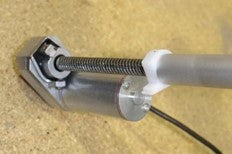Ball screws and lead screws are used for different applications and are often not interchangeable. Both have alternate advantages and disadvantages. If you compare a ball screw and lead screw design yourself, the first thing you might notice is that they are designed to carry loads differently. The way ball screws move a load is through recirculating ball bearings to maximize efficiency and minimize friction. A lead screw relies on the amount of friction between surfaces to be low compared to the amount of pressure being applied. That means that a lead screw does not have the same capability to be as efficient as a ball screw. They also provide linear actuators with better performance or faster speeds, depending on which design model you choose. This article will be focused on closely comparing the two types.
Ball Screws
Ball screws are mechanical linear actuators that create linear motion without friction. They are usually chosen as they have faster rates of speed with continuous duty cycles and can carry higher loads than lead screws. Though they are the more expensive option, they are reliable and easily integrated into a project.
Main Principles of Ball Screws
Their shafts are often made by rolling them out, which gives an operation precision of several thousands of an inch per foot.
Ball screw actuators are made out of either rubber or leather and a fairly bulky cylinder to allow the recirculation of the balls, which is what causes the movement. They have linear seals along the seam,

long carriages for the motion, and various lubrication openings at easy access points along with the mechanism.
Advantages of Ball Screws
Ball screws are efficient as they sacrifice a lot of torque through their construction. They are flexible and have lower friction due to the way they are created. This means that they do not heat up in the same way as a lead screw linear actuator would in a similar situation. The construction also means that they are less liable to break down and need maintenance.
Disadvantages of Ball Screws
The main drawback to the ball screw is the complex design. This makes it more difficult to replace or troubleshoot. They need a hardened precision bearing surface and ball recirculation mechanisms. Ball screws are also not capable of self-regulation. The linear screw actuators they are incorporated into thus requiring separate brakes put on them. These braking mechanisms are specifically required to prevent back driving, which would be bad for the screws. Vertical applications and equipment can also be difficult for ball screw actuators to work with.
Furthermore, these types of screws are incredibly noisy, but this does limit their applications and uses. They are, however, very bulky, which limits them to applications that have lots of available space. A screw driven linear actuator which uses ball screws will need more and more regular lubrication than other types of screws and as stated before, they are more costly than lead screws.
Lead Screws
Lead screw actuators are mainly used when an industry needs a cost-effective solution. These are quiet, flexible, corrosion-resistant and have some self-locking capabilities. The drawback is that they are not as fast and cannot carry the same loads as the ball screw. Lead screws are links between different areas in a mechanism and they are used to create linear motion from rotational motion. Screw threads themselves are divided into two parts, a male and a female. The separation and linking of these two parts is something that causes a lot of friction to build up in the equipment.
Main Principles of Lead Screws
A lead screw actuator has a compact form along with a rotating nut inside a cylinder. The motor in a linear screw drive is constrained within the cylinder, it is the nut that moves. These electric screw actuators are self-locking and have a minimum number of moving parts. Finally, they sometimes have half nuts installed, which can disengage the nut if needed.
One of the popular types of lead screws is the acme screws. These screws come with a twenty-nine-

degree thread angle, something which is easier to create than a square thread. While the increased friction of a triangular thread makes it more inefficient than square ones, these threads are also much stronger. Therefore, the acme screw linear actuators can provide more load-bearing capabilities.
Advantages of Lead Screws
These screws are cheaper and the acme screw actuators which are in self-lock do not require a separate braking system to be installed. They are also more efficient when it comes to vertical applications and equipment.
Disadvantages of Lead Screws
Lead screws need to be replaced much more frequently than other screws. They are also inefficient, due to the way they are constructed. This is due to the need for a larger motor and the existence of torque due to the screws lack of flexibility. Furthermore, the construction means that they produce more friction when working and so produce more heat. They are also not capable of handling high throughput, higher speeds, or longer cycle times.
Conclusion
This article was to discuss the differences and similarities of lead screws and ball screws, and whether one or the other was better. We use lead screws in acme thread actuators, but ball screws have their place in many applications and processes. Lead screws are less expensive than ball screws, but the issue of which type of screw to use is much more complicated than simply the issue of cost. Each one has advantages to particular uses, which means that sometimes it is contingent on the user to look beyond cost to what would be most appropriate.




